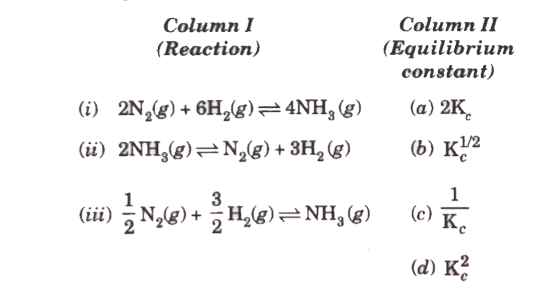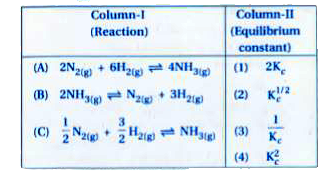This question has Statement I and Statement II. Of the four choices given after the Statements, choose the one that best describes the two Statements
Statement - I : If equilibrium constant for
N2+3H2⇔2NH3 is K,
the equilibrium constant for
12N2+32H2⇔NH3 will be K/2
Statement II: On dividing or multiplying an equation with any number, the equilibrium constant of the reaction changesSolution in Bengali
Statement - I is true, Statement - II is true,
Statement - II is a correct explanation of Statement - I
Statement - I is true, Statement - II ts true,
Statement - II is not a correct explanation of Statement I.
Statement - l is true, Statement- Il is false.
Statement -I is false, Statement- II is true
The correct Answer is:D
Step by step video, text & image solution for This question has Statement I and Statement II. Of the four choices given after the Statements, choose the one that best describes the two StatementsStatement - I : If equilibrium constant for N_2 + 3H_2 iff 2 NH_3 is K, the equilibrium constant for 1/2N_2+3/2 H_2 iff NH_3 will be K/2 Statement II: On dividing or multiplying an equation with any number, the equilibrium constant of the reaction changes by Chemistry experts to help you in doubts & scoring excellent marks in Class 11 exams.
Updated on:21/07/2023Topper's Solved these Questions
Similar Questions
During industrial revolution (in 1860), the amount of carbon dioxide was present in the atmosphere ~ 290 ppm. At present, the amount is ~330 ppm.
This is due to widespread industrialization of
View SolutionWrite formulae for all the isomers of the following. Designate pairs of enantiomers and achiral compounds where they exist. 1-Bromo-4-chlorocyclohexane
View Solutionstatement-1 : If the equation for a reaction is reversed, the equilibrium constant is inverted and if the equation is multiplied by 2, the equilibrium constant is squared. statement-2 : The numerical value of an equilibrium constant depends on the way the equation for the reactions is written.
View SolutionThe equilibrium constant for the reaction
N2+3H2⇔2NH3 is K , then the equilibrium constant for the equilibrium 2NH3⇔N2+3H2 is
View SolutionFor the reaction
N2(g)+3H2(g)⇔2NH3(g)
Equilibrium constant Kc=[NH3]2[N2][H2]3
Some reactions are written below in column I and their equilibrium constants in terms of Kc are written in Column II. Match the following reactions with the corresponding equilibrium constant.

View SolutionFor the given reaction: N2(g)+3H2(g)⇔2NH3(g)
Equilibrium constant Kc=[NH3]2([N2][H2])3
Some reactions are written below in Column-I and their equilibrium constants in terms of Kc are written in Column-II. Match the following reactions with the corresponding equilibrium constant

View SolutionIf N2+3H2⇔2NH3 has equilibrium constant K and 2N2+6H2⇔4NH3 has equilibrium constant k', then k' =
View SolutionThis question has Statement I and Statement II. Of the four choices given after the Statements, choose the one that best describes the two Statements.
Statement - I: van der Waals’ constant ‘b’ of N2 is greater than that of NH3
Statement - II: Molecular Size of N2 is smaller than that of NH3.
View SolutionThis question has Statement I and Statement II. Of the four choices given after the Statements, choose the one that best describes the two Statements
Statement - I: For the equilibrium N2O4(g)⇔2NO2(g), if volume of the vessel is reduced to half of its original volume, equilibrium constant will be doubled.
Statement - II , Decrease of volume to half doubles the concentration of N2O4 as well as NO2
View SolutionThis question has Statement I and Statement It. Of the four choices given after the Statements, choose the one that best describes the two Statements Statement - 1: If an inert gas is added to a dissociation equilibrium keeping pressure constant, the dissociation increases. Statement - II: inert gas exerts its own pressure in the vessel.
View SolutionThis question has Statement I and Statement It. Of the four choices given after the Statements, choose the one that best describes the two Statements
Statement - I : lf reaction quotient (Qc) is less than the equilibrium constant (Kc), the equilibrium tends to shift in the direction of products.
Statement - II : The expression for equilibrium constant is different than the expression for reaction quotient.
View SolutionThis question has Statement I and Statement It. Of the four choices given after the Statements, choose the one that best describes the two Statements Statement - I: If to the equilibrium PCI_5(g) iff PCI_3(g) + Cl_(g) , in a closed vessel, an inert gas is added, total pressuré will increase and hence, equilibrium will shift backward. Statement - II: Addition of an inest gas to an equilibrium mixture at constant pressure shifts the equilibrium in the forward direction.
View SolutionThis question has Statement I and Statement It. Of the four choices given after the Statements, choose the one that best describes the two Statements Statement - I : Equilibrium constant of all reactions changes with change of temperature. Statement - II : With increase in temperature, both forward and backward reactions are speeded up but to different extents.
View SolutionThis question has Statement I and Statement It. Of the four choices given after the Statements, choose the one that best describes the two Statements
Statement - I : For the reaction
N2(g)+3H2(g)⇔2NH3(g)
Units of Kc=L2mol−2
Statement - II : For the reaction
N2(g)+3H2(g)⇔2NH3(g)
Equilibrium constant, Kc=[NH3]2[N2][H2]3
View SolutionIf the equilibrium constant for N2(g)+O2(g)⇔2NO(g) is K, the equilibrium constant for 12N2(g)+12O2(g)⇔NO(g) will be:
View Solution
